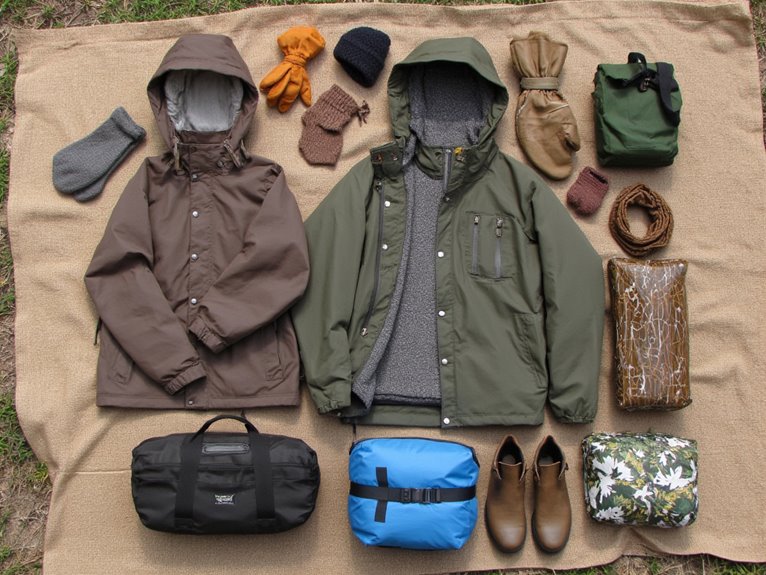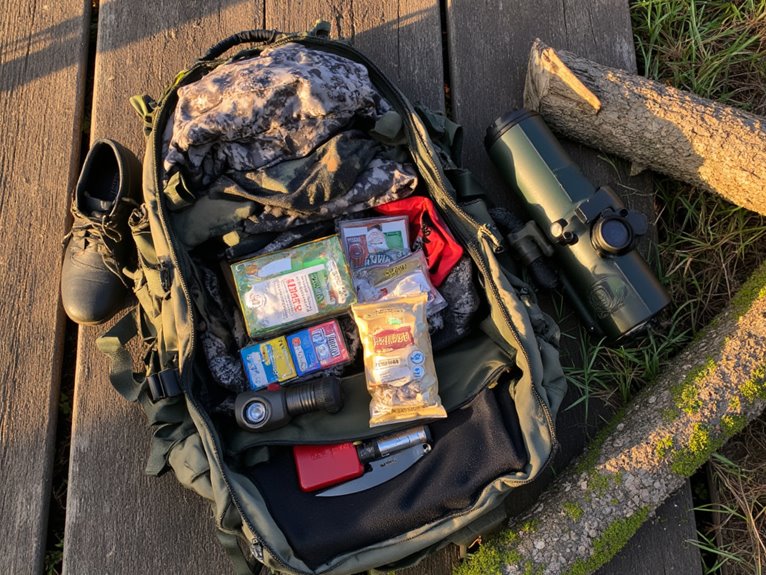Packing Tips for Multi-Day Hunting Trips
For multi-day hunting trips, you’ll want to target a 20-25 kg pack weight while prioritizing essentials: weapon, ammunition, food, water, and sleeping system. Use moisture-wicking base layers, breathable mid-layers, and quiet waterproof outer shells for variable conditions. Pack heavy items close to your frame, roll clothing tightly, and store sleeping bags at the bottom with navigation tools on top. Include first aid supplies, GPS units, and emergency communication devices in waterproof containers. Master these fundamentals to access advanced expedition techniques.
We are supported by our audience. When you purchase through links on our site, we may earn an affiliate commission, at no extra cost for you. Learn more. Last update on 27th December 2025 / Images from Amazon Product Advertising API.
Notable Insights
- Target a pack weight of 20-25 kg by prioritizing essential gear and choosing ultralight options like titanium cookware.
- Use layered clothing systems with moisture-wicking base layers, insulating mid-layers, and waterproof outer shells for versatility.
- Pack heavy items close to the frame and organize by frequency of use with navigation aids accessible.
- Include waterproof first aid supplies, GPS units, emergency beacons, and hunter orange safety gear for protection.
- Plan 2,500-3,000 daily calories using pre-packaged rations and carry lightweight water purification methods for sustained energy.
Essential Gear Selection and Weight Management
When planning a multi-day hunting expedition, your gear selection and weight management strategy will ultimately determine whether you return home successful or struggle through days of unnecessary fatigue and discomfort.
Target a pack weight of 20-25 kg (45-55 lbs) for peak performance. Prioritize essential gear categories: weapon and ammunition, knives, food and water, sleeping system, and toiletries.
Target 20-25 kg pack weight for optimal hunting performance by prioritizing weapons, food, water, sleep gear, and essential toiletries only.
Choose ultralight versions whenever possible—titanium cookware instead of steel, minimalist sleeping pads over thick foam models. The MSR PocketRocket 2 stove weighs just 2.6 ounces while delivering reliable performance. Select a lightweight two-person tent under 3 pounds for overnight stays to maintain mobility without sacrificing shelter protection.
Eliminate non-essential items ruthlessly. Use multi-purpose equipment for maximum weight reduction. Share common gear like stoves and first aid kits with hunting partners to distribute load efficiently across your team. Consider bivy sacks for their versatility and quick setup when you need immediate shelter without the bulk of a traditional tent.
For footwear, invest in quality waterproof boots that combine durability with comfort, as wet feet can quickly compromise your hunting effectiveness and safety during extended outdoor adventures.
Clothing Systems for Variable Weather Conditions

Beyond selecting the right gear and managing pack weight, your clothing system serves as your primary defense against hypothermia, overheating, and moisture-related discomfort during multi-day hunts.
Modern clothing technologies like Gore-Tex membranes and merino wool fibers provide superior performance compared to traditional materials. Your three-layer system starts with moisture-wicking base layers featuring antimicrobial silver additives. Merino wool regulates temperature while synthetic blends offer durability for extended use. Quality merino base layers naturally resist odor throughout extended hunting trips.
Effective layering techniques require strategic mid-layer selection. Choose fleeces or synthetic insulation that breathe during exertion yet retain warmth during inactive periods. Wind-resistant materials add protection without bulk.
Your outer layer must balance waterproofing with breathability. Look for quiet fabrics with pit zips for ventilation control. Understanding the distinction between waterproof vs. water-resistant materials helps ensure adequate moisture protection during extended exposure to harsh conditions. Proper layering techniques enable micro-adjustments through zippers and removable sections, maintaining ideal body temperature across varying activity levels and weather conditions. Store your clothing items in compression sacks to maximize valuable pack space while keeping everything organized.
Efficient Packing Strategies and Organization Methods
Strategic packing transforms a cumbersome load into a balanced, accessible system that enhances your hunting effectiveness throughout the expedition. Effective packing techniques begin with proper gear prioritization based on retrieval frequency.
Smart packing converts heavy gear into an organized, efficient system that maximizes your hunting performance in the field.
Place sleeping bags and field dressing equipment at the bottom for stability. Position backup weather gear in the middle section for emergency access. Keep navigation aids and hunting essentials at the top for immediate availability.
Roll clothing instead of folding to maximize space compression. Use stuff sacks for bulky items like sleeping bags. Fill empty pockets with small gear to eliminate wasted volume. Group similar items together and separate them with padded layers to prevent noise.
Position heavy items close to the pack frame above your hip belt. This weight distribution improves balance and reduces fatigue on challenging terrain.
Safety Equipment and Emergency Preparedness
Although proper gear organization maximizes hunting efficiency, your safety equipment serves as the critical foundation that protects life and guarantees successful trip completion. Pack essential first aid supplies in waterproof containers including bandages, antiseptic wipes, painkillers, and tourniquets for bleeding control. Carry reliable navigation tools such as GPS units, compasses, and topographic maps specific to your hunting area.
| Equipment Category | Essential Items |
|---|---|
| Medical Supplies | First aid kit, tourniquet, prescription medications |
| Navigation Tools | GPS unit, compass, topographic maps |
| Communication | Satellite beacon, emergency whistle |
| Personal Protection | Hunter orange vest, safety harness, multitool |
Include emergency shelter materials and fire-starting equipment for unexpected overnight situations. Test all devices beforehand and inform trusted contacts about your detailed trip plans. Store critical documents like hunting licenses and emergency contacts in fireproof and waterproof containers to ensure they remain accessible even if exposed to harsh weather conditions or accidental water damage.
Food Planning and Shelter Requirements
After securing your safety foundation, proper nutrition and shelter planning directly impact your hunting performance and endurance throughout multi-day expeditions.
You’ll need 2,500-3,000 calories daily to maintain energy levels during intensive hunting activities. Pre-package complete daily rations in gallon-sized zip bags containing breakfast oatmeal packets, lunch jerky and trail mix, plus freeze-dried dinner meals. This system guarantees proper nutritional balance while eliminating guesswork in the field.
Your shelter system must balance weather protection with pack weight constraints. Choose compact, weather-appropriate tents or tarps based on forecast conditions. For sleeping comfort in varying temperatures, consider sleeping bags with temperature ratings suitable for expected nighttime conditions and features like compression sacks for efficient packing.
Pack essential accessories including stakes, guy lines, and repair kits for reliable setup.
Don’t forget meal hydration requirements. Include lightweight water filters or purification tablets, plus cooking fuel and utensils for proper meal preparation in backcountry conditions.
On a final note
You’ve got the framework for successful multi-day hunting trips. Your gear selection determines trip success. Layered clothing systems adapt to changing conditions while proper organization saves time and energy. Don’t compromise on safety equipment—it’s non-negotiable. Emergency preparedness prevents minor issues from becoming major problems. Food planning maintains energy levels throughout your hunt. Quality shelter guarantees proper rest. Execute these strategies systematically, and you’ll maximize your hunting effectiveness while minimizing unnecessary risks in the field.

